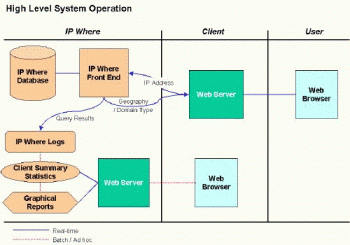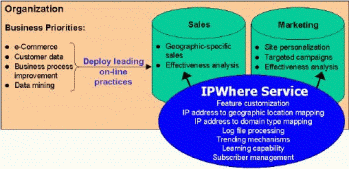Design Team Members: Ryan Anderson, Erick Vandeweghe
Supervisor: Dr. Paul Guild
Background
The projected growth in e-Business revenues is phenomenal. Forrester Research predicts that global revenues realized through the application of e-Business concepts and technologies will reach $1.3 trillion by 2003. Competition in this space is fierce as traditional businesses seek to defend their turf against innovative and aggressive startups that are backed by extensive venture capital. As businesses endeavour to capture a share of the online business trade they will be looking for innovative products and services to help them attract and service customers in the internet space. IPWhere is such a service – one that will map an IP address to a user’s geographic location and domain type.
Project description
The IPWhere system will estimate the location of a server by the city address of the administrator of the domain name; this information can be searched and parsed from Reverse DNS and whois information. The information will then be organized in a central database and presented to IPWhere customers through a graphical interface and customizable log file. The diagram below shows the interfaces and communiction between the various sections of the IPWhere system.

The IPWhere service will be useful to e-Commerce sites for a variety of reasons including personalization of the web site to match the user’s geographic location, on-line targeted marketing, marketing effectiveness analysis, sale of geographic specific goods or services and sales effectiveness analysis. IPWhere will help businesses develop the internet channel and realize goals therein such as operational efficiencies, extending geographic boundaries and realizing new sources of revenue. To this end, the IPWhere service will provide multiple modes of operation: The functionality will include real-time geographic and domain type mapping, batch log file processing and reporting, and graphical summary reporting. This diverse functionality will make IPWhere valuable in a variety of business situations.

Design methodology
The project has been divided into four major stages, as listed below:
Research and Analysis. The market within IPWhere must be fully understood, including the technology trends, the presence of competitors, the availability of substitute products, and the needs of the customer. Second, and more importantly, the technology and information available to implement the service must be investigated, so that the overall feasbility of the project is proven and a high-level understanding of the project implementation may be understood. Technology and implementation paths will be judged against one another to assess their relative worth and role in the overall project.
Algorithm Development. Algorithm Development outlines the medium-level processes that must be completed in order to accomplish the project goals. These processes will be technology-agnostic; that is, no software or hardware platforms will be specified, nor will protocols or languages be selected.
System Development. Upon determining the medium level processes, the project will be implemented with the appropriate technologies. This stage will include the selection of the hardware and software, and its implementation in softwre code, network architecture, and database design.
Value Added Services. During the development of the system, there will be several additional services identified that do not comprise the intended base functionality of IPWhere, but would serve as suitable complements to the service. In this stage, these services will be implemented as time permits.